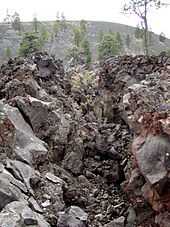Sunset Crater
| Sunset Crater | |
|---|---|
 Sunset Crater with Ponderosa pines on the slope | |
| Elevation | 8,042 ft (2,451 m) NAVD 88[1] |
| Location | |
 | |
| Location | Coconino County, Arizona, U.S. |
| Range | San Francisco volcanic field |
| Coordinates | 35°21′56″N 111°30′02″W / 35.365579283°N 111.500652017°WCoordinates: 35°21′56″N 111°30′02″W / 35.365579283°N 111.500652017°W[1] |
| Topo map | USGS Sunset Crater East |
| Geology | |
| Type | Cinder cone[2] |
| Age of rock | ~950 years |
| Last eruption | 1080–1150 AD[2] |
| Climbing | |
| Easiest route | Hike |
Sunset Crater is a volcanic cinder cone located north of Flagstaff in U.S. State of Arizona. The crater is within the Sunset Crater Volcano National Monument.
Sunset Crater is the youngest in a string of volcanoes (the San Francisco volcanic field) that is related to the nearby San Francisco Peaks.[3]

The date of the eruptions that formed the 340-meter-high cone (1,120 ft) was initially derived from tree-ring dates, suggesting the eruption began between the growing seasons of A.D. 1064–1065.[4] However, more recent geologic and archaeological evidence places the eruption around A.D. 1085.[5] The largest vent of the eruption, Sunset Crater itself, was the source of the Bonito and Kana-a lava flows that extended about 2.5 kilometers (1.6 mi) NW and 9.6 kilometers (6 mi) NE, respectively. Additional vents along a 10-kilometer-long fissure (6.2 mi) extending SE produced small spatter ramparts and a 6.4-kilometer-long lava flow (4 mi) to the east. The Sunset Crater eruption produced a blanket of ash and lapilli covering an area of more than 2,100 square kilometers (810 sq mi) and forced the temporary abandonment of settlements of the local Sinagua people.[2] The volcano has partially revegetated, with pines and wildflowers. The crater is the namesake for the Sunset Crater Beardtongue (Penstemon clutei).
Damage from hikers forced the National Park Service to close a trail leading to the crater, but a short trail at the base remains.[6]
The hiking trail below the summit skirts the substantial Bonito Lava Flow. This hardened lava is black and appears fresh as it has devastated the forest in its path. The lava flow also created an ice cave or tube that is now closed to the public after a partial collapse.
Sunset Crater Volcano National Monument
| Sunset Crater Volcano National Monument | |
|---|---|
|
IUCN category III (natural monument or feature) | |
 | |
| Nearest city | Flagstaff, AZ |
| Area | 3,040 acres (1,230 ha)[7] |
| Established | May 26, 1930 |
| Visitors | 185,265 (in 2011)[8] |
| Governing body | National Park Service |
Sunset Crater Volcano National Monument is a U.S. National Monument in the north-central part of the U.S. state of Arizona, created to protect Sunset Crater, a cinder cone within the San Francisco Volcanic Field.[9] The monument is managed by the National Park Service in close conjunction with nearby Wupatki National Monument. In 1928, a Hollywood film company - Famous Players-Lasky Corporation - planned to detonate large quantities of explosives on the side of Sunset Crater in order to create an avalanche for Zane Grey's motion picture, "Avalanche".[10] Public outcry over this plan led in part to the proclamation of Sunset Crater Volcano National Monument by President Herbert Hoover in 1930.[11]
A one-mile (1.6 km) self-guided loop trail is located at the base of Sunset Crater but hiking to the summit is not permitted. A trail providing access to the summit and crater was closed in 1973 because of excessive erosion caused by hikers.[12] A visitor center is located near the park entrance, 15 miles (24 km) north of Flagstaff, Arizona, along U.S. Highway 89.
References
- ↑ 1.0 1.1 "Sunset Crater". NGS data sheet. U.S. National Geodetic Survey. Retrieved 2008-12-23.
- ↑ 2.0 2.1 2.2 "Sunset Crater". Global Volcanism Program, Smithsonian Institution. http://www.volcano.si.edu/world/volcano.cfm?vnum=1209-02-. Retrieved 2008-12-23.
- ↑ Priest, Susan S.; Wendell A. Duffield, Karen Malis-Clark, James W. Hendley II, and Peter H. Stauffer (2001-12-21). "The San Francisco Volcanic Field, Arizona - U.S. Geological Survey Fact Sheet 017-01". United States Geological Survey. Retrieved 2008-08-12.
- ↑ Pilles, Peter J. Jr. 1979, Sunset Crater and the Sinagua: A New Interpretation. In Volcanic Activity and Human Ecology, edited by Payson D. Sheets and Donald K. Grayson, pp. 459-485. Academic Press, New York.
- ↑ Elson, Mark D., Michael H. Ort, Paul R. Sheppard, Terry L. Samples, Kirk. C. Anderson, and Elizabeth M. May 2011, A.D. 1064 No More? A Multidisciplinary Re-evaluation of the Date of the Eruption of Sunset Crater Volcano, Northern Arizona.Paper presented at the 76th Annual Meeting of the Society for American Archaeology, Sacramento, California.
- ↑ "Lava Flow Trail". Sunset Crater Volcano National Monument. National Park Service. 2006-09-14. Retrieved 2008-08-12.
- ↑ "Listing of acreage as of December 31, 2011". Land Resource Division, National Park Service. Retrieved 2011-12-30.
- ↑ "NPS Annual Recreation Visits Report". National Park Service. Retrieved 2011-12-30.
- ↑ "Sunset Crater Volcano National Monument". National Park Service. 2007-09-14. Retrieved 2008-08-12.
- ↑ "America's Best Idea: Sunset Crater nearly destroyed by Hollywood". KNAU, NPR. 2009-10-02.
- ↑ "Sunset Crater Volcano National Monument - People". National Park Service. 2007-03-20. Retrieved 2012-01-27.
- ↑ "Frequently Asked Questions". National Park Service. Retrieved 2011-06-18.
External links
| Wikimedia Commons has media related to Sunset Crater Volcano. |
- Official National Park Service Sunset Crater National Monument website
- Geology of Sunset Crater - USGS
| |||||||||||||||||||||||||||||||||||||||||||||||||||||||||||||